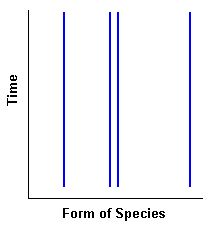|
Perhaps you drew a graph like this.
If species were created by a designer you would expect them to
be "perfect" and unchanging since the day they were
created.
(Of course, if the designer was a poor craftsman, maybe he needed
a lot of experiments before he found something that worked.)
Regardless, the fossil record for a world dominated by Natural
Theology would not have the branching pattern we see in the data.
|  |
In this first lesson I have tried to show you that science is
a method that searches for truth by focusing strongly on evidence.
Anyone can come up with a good idea but the scientific method
requires that ideas be "falsifiable" meaning that a
hypothesis must be able to make a testable prediction or present
an observable outcome. Because science is based upon data and
observations any new theory that runs contrary to the "popular"
view must be given serious consideration if it explains observations
or predicts events better than the current theory.
All primitive societies have independently "evolved"
their own theory of evolution similar to Paley's Natural Theology
theory. But none of them have been able to explain the fossil
record. (Some argue that the designer created the fossil record
to confuse or test us, but that hypothesis is impossible to disprove
so it isn't scientific.) Besides, if all species were created
by a designer, who designed the designer?! Any explanation for
the origin of the designer is also untestable and therefore unscientific.
Lamarck's theory of the Inheritance of Acquired Characteristics was
a pretty good idea for its time. Indeed, Charles Darwin's grandfather
(Erasmus Darwin) was a great proponent of Lamarck's work. Many
good scientists found Lamarck's ideas suitable and easy to understand,
but when careful observations were made and proper experiments
performed, the theory of Inheritance of Acquired Characteristics
was found to be full of holes.
Darwin's (and Russell's) theory of evolution by Natural Selection
not only explains our wonderfully diverse world and how species
adapt, but it also makes predictions that are testable and it
presents itself well to experimentation. It is so well accepted
by today's scientists that we simply call it "evolution"
or "Darwinian evolution" and assume that we all know
we are talking about Darwin's theory of descent with modifications.
In the next lesson you will learn about some of the evidence for
evolution.
You have completed lesson 1 and now is a good time to take a break and review your notes.
If you like, you can
return to the contents page or
go on to Lesson 2.
This work was created by Dr Jamie Love  and
and  licensed under a Creative Commons Attribution-ShareAlike 4.0 International License.
licensed under a Creative Commons Attribution-ShareAlike 4.0 International License.
If you like, you can return to the Home Page.

 and
and  licensed under a Creative Commons Attribution-ShareAlike 4.0 International License.
licensed under a Creative Commons Attribution-ShareAlike 4.0 International License.